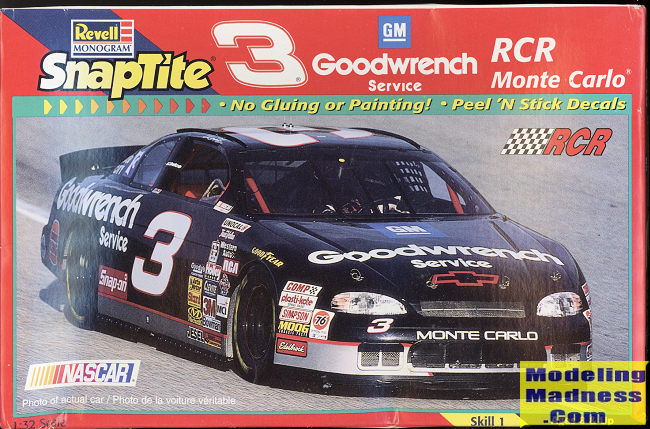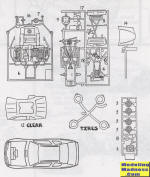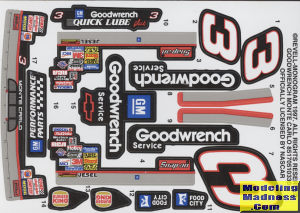
Revell-Monogram 1/32 Goodwrench Monte Carlo
| KIT #: | 1705 |
| PRICE: | $6.50 'used' |
| DECALS: | One livery |
| REVIEWER: | Scott Van Aken |
| NOTES: | 1997 Snap Kit |

| HISTORY |
Ralph Dale Earnhardt Sr. (April 29, 1951 – February 18, 2001) was an American professional stock car driver and team owner, who raced from 1975 to 2001 in the former NASCAR Winston Cup Series (now called the NASCAR Cup Series), most notably driving the No. 3 Chevrolet for Richard Childress Racing. The third child of racing driver Ralph Earnhardt and Martha Earnhardt, he began his career in 1975 in the World 600. Earnhardt won a total of 76 Winston Cup races over the course of his 4 decade career, including four Winston 500s (1990, 1994, 1999, and 2000) and the 1998 Daytona 500. He also earned seven Winston Cup championships, a record held with Richard Petty and Jimmie Johnson. His aggressive driving style earned him the nicknames "The Intimidator", "The Man in Black", and "Ironhead". He is regarded as one of the greatest drivers in NASCAR history.[
On February 18, 2001, Earnhardt died in a sudden last-lap crash during the Daytona 500, an event that is regarded in the racing industry as being a crucial moment in improving safety in all aspects of car racing, especially NASCAR. Earnhardt has been inducted into numerous halls of fame, including the NASCAR Hall of Fame inaugural class in 2010.
| THE KIT |
 Back in the late 1980s/early 90s, NASCAR was a big deal. The model
companies caught on to this and began producing kits by the thousands to meet
the demand. Not only standard kits, but smaller ones for the snap-kit market.
Both AMT and Monogram produced these kits, but they did so in a slightly
different way. The AMT kits were more like standard kits, but with very large
mounting pins/sockets. Monogram, on the other hand, went with a kit that had
even fewer parts, as you can see by the parts layout diagram. The Monogram kit has pretty much the same detailing as the AMT
version, but for instance, all the side roll cage parts are incorporated into
the floor pan and one folds them up during assembly. The engine is also designed
a bit differently with fewer parts.
Back in the late 1980s/early 90s, NASCAR was a big deal. The model
companies caught on to this and began producing kits by the thousands to meet
the demand. Not only standard kits, but smaller ones for the snap-kit market.
Both AMT and Monogram produced these kits, but they did so in a slightly
different way. The AMT kits were more like standard kits, but with very large
mounting pins/sockets. Monogram, on the other hand, went with a kit that had
even fewer parts, as you can see by the parts layout diagram. The Monogram kit has pretty much the same detailing as the AMT
version, but for instance, all the side roll cage parts are incorporated into
the floor pan and one folds them up during assembly. The engine is also designed
a bit differently with fewer parts.
Both kits have a chassis where one snaps in place the wheel/tire
assembly. The exhaust is also incorporated with the front suspension detail.
There is a separate engine and as I mentioned, the majority of the roll cage is
molded onto the interior pan. The seat is molded onto this pan. This all sits
atop the chassis pan. A single clear part deals with the windows and fits into
pegs under the roof. The body has a separate hood and both are in color to match
the majority of the livery scheme. In this case, it is black.

Instructions are 11 steps and nicely drawn. Some color information is provided during the build. Like the real deal, the body parts are black with everything else in red. Apparently R-M felt that the target audience couldn't handle decals so they provide stickers instead. These are very nicely printed. How viable they are after 25 years is unknown.
| CONCLUSIONS |
These kits are designed for beginning modelers. As in kids. Their ease of construction and the use of stickers instead of decals shows that. However, older modelers may be drawn to them as a way to build something easy after a tough project. Slot car enthusiasts will like these as well as a source for bodies for a project.
| REFERENCES |
https://en.wikipedia.org/wiki/Dale_Earnhardt
April 2021
Copyright ModelingMadness.com. All rights reserved.
If you would like your product reviewed fairly and fairly quickly, please contact the editor or see other details in the Note to Contributors.
Back to the Main Page Back to the Previews Index Page Back to the Review Index Page